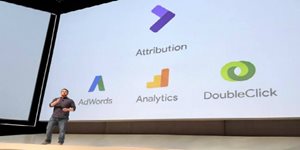Google Will Track Down Credit Card Payments for Advertisers
By Venus Tamturk
May 25, 2017
Advanced Analytics, Analytics, big data, data, Data Security, ecommerce, Google, machine learning, marketing, smart data
By now, as marketers, we all understand how prominent it is to deliver an omnichannel experience that is a true continuity of experience across multiple interactions and consistent on multiple devices. However, we are still vulnerable when it comes to measuring the contributions of upper- and mid-funnel marketing and advertising efforts. Therefore, even though we are able to generate a number of touchpoints with customers throughout the customer journey, we are limited to evaluating the contribution of disparate advertising efforts. Well, Google says: “Not anymore!”
that is a true continuity of experience across multiple interactions and consistent on multiple devices. However, we are still vulnerable when it comes to measuring the contributions of upper- and mid-funnel marketing and advertising efforts. Therefore, even though we are able to generate a number of touchpoints with customers throughout the customer journey, we are limited to evaluating the contribution of disparate advertising efforts. Well, Google says: “Not anymore!”
This week, in San Francisco at its annual event, Google Marketing Next, announced a new beta for Google Attribution, a tool that will help advertisers understand whether their online marketing campaigns actually lead to offline sales by measuring the relevant contribution of every single touchpoint along consumers' paths to purchase.
What Does New Google Attribution Address?
Until now, marketers have been heavily relying on the last-click model when they were evaluating conversions because simply, this model has been the easiest way to measure. However, there are so many drawbacks of this method as it gives credit to only consumer's last action before buying something, whereas prior touch points such as email, display impressions, generic search ads and so forth may have also led to the sale. So ignoring the prior interactions along a conversion path and only preceding the final touch before a conversion do not paint a holistic picture of consumer behavior thus it causes blind spots for marketers. “Existing attribution tools… just aren’t cutting it,” Bill Kee, Google’s group product manager for attribution, told some 1,000 marketers at the conference.
In recognition of these shortcomings, Google redesigned its Attribution, which is offered for free, to focus on understanding the full customer journey instead of being limited to referencing the last-click impact, so marketers can view a more accurate cost-benefit analysis of their advertising efforts.
The company stated: "For the first time, Google Attribution makes it possible for every marketer to measure the impact of their marketing across devices and cross-channel - all in one place."
How Google Attribution Works
The tool supports the data-driven attribution model which utilizes machine learning algorithms in order to dictate how much credit to assign to each interaction along the consumer journey. From there, it provides the analysis of an account's unique conversion patterns, comparing the paths of customers who convert to those who don’t. As a result, a marketer who receives this report can make an informed decision on bidding more on a channel that performs well or revoking budget from any marketing tactic that doesn’t lead to sales. In short, the idea behind this is to provide insight on every advertising dollar’s effectiveness across different channels and devices.
Google’s vice-president of product management, Jerry Dischler, said: “There has never been a more exciting time to be a marketer, especially online, because [brands] can access their customers at any moment throughout the day as they bounce across devices including tablets, mobile, and desktop,” and added: “But this has created unprecedented complexity. There is more data, more platforms, and more channels. On a daily basis, Google Analytics processes half a trillion digital moments across devices. What we are trying to do is use tech and machine learning to help make ad platforms more useful, easier and better connected.”
In order to use Google Attribution, accounts must have at least 15,000 clicks and a conversion action with at least 600 conversions within 30 days. Google also announced a product called Attribution 360 to attract agencies that roll out large campaigns. Its annual price starts at $150,000, and it offers several other features on top of what the free version provides, including custom data integrations so marketers can utilize their own data and attribution to television ads.
To make a shift from the old last-click paradigm, Google actually rolled out the data-driven model in 2013 and the company geared up its effort when it acquired Adometry, a startup focused on the multichannel attribution service, in 2014. Shortly after the acquisition, the company weaved into its enterprise offerings, Google’s Analytics 360 Suite, and Google AdWords. Almost a year ago Google-enabled search marketers to assign an attribution model to conversion events in AdWords. In fact, Google is not the only one that has been developing tools to break the strong reliance on last click as Adobe and a couple of startups such as BrightFunnel and Bizible have been working on this model for years. That being said, Google doesn’t seem to bill its offering as the best tool in the market, but it does emphasize its differentiating factors such as ease of use, numerous integrations, and the cost.
Google Tracks Down Credit Card Purchases
At the event, Google also revealed its plans to track down billions of purchase transactions through debit and credit cards, aiming to link offline purchases to online ads. In the scope of providing marketers better understanding of consumer behaviors, in the upcoming months, Google will launch new capabilities that give insight into the impacts of the online advertising efforts on the in-store sales. When a user has seen an ad, Google will be able to tell whether they have searched for the product advertised and gone to an offline shop to buy it.
Retailers also will be able to measure in-store revenue by importing store transactions directly into AdWords and data from store loyalty programs. Even “if your business doesn't have a large loyalty program, you can still measure store sales by taking advantage of Google's third-party partnerships, which capture approximately 70% of credit and debit card transactions in the United States," Sridhar Ramaswamy, Google's senior vice president of Ads and Commerce said. "There is no time-consuming setup or costly integrations required on your end. You also don’t need to share any customer information. After you opt in, we can automatically report on your store sales in AdWords."
The technology was actually rolled out over two years ago and it has measured more than 5 billion store visits across 17 countries in the last 30 months. From the early testing, here are some stats that Google has found:
-
7 in 10 smartphone owners who make in-store purchases take relevant action on their  phone prior to purchase.
phone prior to purchase.
-
Consumers who click on a Google search ad before visiting a store are 25% more likely to make a purchase.
-
They also spend 10% more on average.
Virgin Holidays claimed that when it factors in store sales, its search campaigns generate double the profit compared to looking at online KPIs alone. A customer purchasing in-store after clicking on a search ad is also three times more profitable than an online conversion.
It's rolling out in-store visit measurements to YouTube video ads soon. With the new enhancement, Google will share local store hours, directions and product available in the store just after commercials on YouTube. Google even ran a test last year, and as a result, nearly a million people visited Wendy’s and ordered a square-shaped hamburger or some nuggets after the commercials.
Lastly, Google announced its improved proposition for marketers: search ads that appear only for "in-market" shoppers. According to Google, the tool powered by machine learning analyzes trillions of search queries and activity across millions of websites to help figure out when people are close to buying and surface ads that will be more relevant and interesting to them.
How About User Privacy?
All of this tracking down of very personal information naturally brings privacy concerns to the surface. To address this concern, Google reassured that the measurement of store visits will be aggregated and anonymized and no location data will be shared with advertisers. Users can deactivate the service from their ads setting page by unchecking the box which states: “Also use Google Account activity and information to personalize ads on these websites and apps and store that data in your Google Account". Speaking of personalization, users can also opt out of personalized Google Ads.
As Ramaswamy said, the service is limited to the US for the time being, but it will not be easy to launch it in Europe due to the upcoming General Data Protection Regulation.
"The one thing people regularly state as 'creepy' online is when an advert follows them around  the internet. These plans appear to extend 'creepy' into the physical world," said Renate Samson from Big Brother Watch to BBC and added: "If people want to avoid having their shopping habits monitored on the high street by Google, by shops or by banks they should restrict the amount of data they hand over. Companies track and monitor in order to advertise to us. If we don't want them to do that, take control; don't give your email address for a digital receipt, check the terms and conditions, avoid using loyalty cards and where possible choose to pay with cash."
the internet. These plans appear to extend 'creepy' into the physical world," said Renate Samson from Big Brother Watch to BBC and added: "If people want to avoid having their shopping habits monitored on the high street by Google, by shops or by banks they should restrict the amount of data they hand over. Companies track and monitor in order to advertise to us. If we don't want them to do that, take control; don't give your email address for a digital receipt, check the terms and conditions, avoid using loyalty cards and where possible choose to pay with cash."
My POV
With the explosion of data and ways of gathering it, the process of translating it into actionable recommendations is getting harder and harder. I mean, even Facebook confessed that they have found 10 different errors in its measurement which caused overbilling of some customers. No wonder marketers are struggling with measuring their marketing efforts and proving marketing ROI. Therefore, it is no secret that all these capabilities announced by Google are so necessary for marketers and retailers who want to proactively measure the impact of every digital investment on their online and offline sales revenue. Even though the value proposition when you use the tool integrating with the other Google ad tools is loud and clear, the company’s claim on “across all channels” remains vague to me as it is not clearly defined how Attribution will incorporate with data from other tools.

Venus Tamturk
Venus is the Media Reporter for CMS-Connected, with one of her tasks to write thorough articles by creating the most up-to-date and engaging content using B2B digital marketing. She enjoys increasing brand equity and conversion through the strategic use of social media channels and integrated media marketing plans.